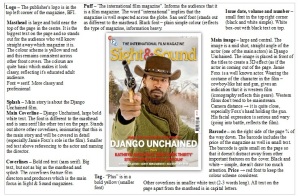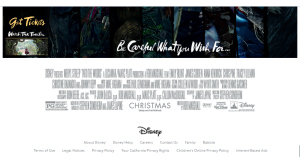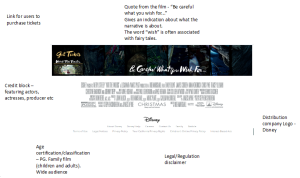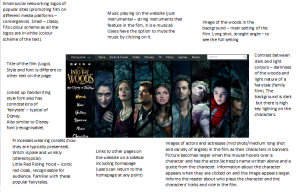 Sight & Sight magazine in a serious and independent magazine that is targeted at a niche audience of educated film experts as it is very information heavy and focuses on more on directors, auteurs and independent and art house films. This is seen in the magazine cover as the splash is about the western film ‘Django Unchained’ and western films tend to have a niche audience as it isn’t normally mainstream (specific genre). Also, the film is an classified as an 18 by the BBFC which suggests that the magazine has an older demographic (18-50) as they will be able to watch the film and understand how the film pushes boundaries from a mature perspective. The splash informs the audience that the main article in the magazine focuses on ‘Django Unchained’ and the coverline in bold red font indicates that story will focus on the director, Quentin Tarantino and the same cover-line and main image also implies that the main story will focus particularly on Jamie Foxx’s role in the film as well (as he plays the main character). However, the text with Foxx’s name in it is in a small font which reflects the idea that the magazine doesn’t focus on actors in as much detail as more mainstream film magazines and hybrid magazines such as celebrity gossip.
Sight & Sight magazine in a serious and independent magazine that is targeted at a niche audience of educated film experts as it is very information heavy and focuses on more on directors, auteurs and independent and art house films. This is seen in the magazine cover as the splash is about the western film ‘Django Unchained’ and western films tend to have a niche audience as it isn’t normally mainstream (specific genre). Also, the film is an classified as an 18 by the BBFC which suggests that the magazine has an older demographic (18-50) as they will be able to watch the film and understand how the film pushes boundaries from a mature perspective. The splash informs the audience that the main article in the magazine focuses on ‘Django Unchained’ and the coverline in bold red font indicates that story will focus on the director, Quentin Tarantino and the same cover-line and main image also implies that the main story will focus particularly on Jamie Foxx’s role in the film as well (as he plays the main character). However, the text with Foxx’s name in it is in a small font which reflects the idea that the magazine doesn’t focus on actors in as much detail as more mainstream film magazines and hybrid magazines such as celebrity gossip.
The main image is a large mid shot, straight angle of Jamie Foxx’s (well known actor) character from ‘Django Unchained’ which also emphasises the idea that Sight & Sound focuses more on the actual film than the actors. The image supports the anchorage text, which is the main cover-line that refers to the film (and actor and director), because the image features a character from the film. The image is placed in front of the masthead which gives it a 3D effect as it makes the image look like the character is pointing the gun at the reader (the camera distance of Foxx’s hand holding the gun is very close). The image also uses direct address (the character is looking into the camera) which directly interacts with the audience to obtain their attention as the magazine wants a close relationship with the reader and wants them to be attracted to the magazine so that they can purchase and read it, so the publishers can make money from this. The cowboy-like hat and gun are stereotypical conventions of a western film (iconography) along with the brown colours, so this gives the readers a visual interpretation of the western genre of the film. His facial expression is quite serious and wary (as if he was going into battle), which conveys to the audience that there is action and violence in the film (also indicated by the gun).
The masthead is large and bold and is placed near the top of the page in the centre which stands out to the reader so they automatically know which magazine it is as it is the largest text on the page. The font of the text is different to the fonts of other text on the cover, which is typical across many magazines, to make it recognisable to the audience as a specific font (own brand). The font is serif which has connotations of professionalism and also indicates that the magazine is well respected and traditional (Sight & Sound was first established in the 1930s). Therefore, readers will trust the magazine because it has been around for a long time. The colours in the masthead are red and yellow which are basic colours to make the magazine cover look classy, reflecting its educated, adult audience. The colour scheme of the magazine is red, yellow and white and this remains consistent throughout the front cover. The masthead also uses alliteration, the ‘s’ letters in “Sight & Sound” which makes the name of the magazine sound distinctive.
The puff (tag line), “The international film magazine” informs the audience that it is a film magazine. The adjective “international” insinuates that the magazine is well respected by the countries across the globe. The sans serif font makes the puff stand out as different to the masthead and the black colour is plain and simple which reflects the the serious nature of the magazine (information heavy). The capital letters makes the text clearer to the audience and indicates it’s importance. The puff provides support for the masthead as it gives further detail and context into what ‘Sight & Sound’ is.
The cover-lines are in bold red font in capital letters (sans serif). The text is big but not large as the main “Django Unchained” cover-line which indicates that these articles aren’t as significant as the ‘Django Unchained’ article due to the fact that it is the main article. This is further emphasised by the fact that the text of “Django Unchained” is white which is a different colour to the other cover-lines to make it stand out as the most important feature. The other red cover-lines feature the film and director names, for example “Kathryn Bigelow’s ‘Zero Dark Thirty’”, emphasising that directors are a main focus in Sight & Sound magazines. Other cover-lines are in even smaller font and the text is white and tends to be 2-3 words long, informing the audience about other articles and features in the magazine. But, the small font implies that these features aren’t as significant as the other articles referenced to in the cover-lines with larger text.
Other typical magazine conventions that are seen on the cover are the barcode, price, date, issue number/volume. These items are placed discretely on the front cover. The barcode is placed on the right side on the edge of the page three quarters of the way down and includes the price of the magazine. It is also quite small so that it doesn’t distract the audience away from other main features of the magazine. The date, issue number/volume is placed in the top right corner of the page and is also very small and discrete. It is placed simply in a box-out (black text layered on a white box) which reflects the simplistic nature of the layout of the magazine. The front cover is quite sparse as there isn’t much text and only features one image on it which is complete contrast to mainstream magazines with larger/broader audiences. The publisher’s logo, BFI, also features in the top left corner of the page. Readers would trust the magazine as the demographic that the magazine is targeted at would be familiar with the BFI because they tend to be film experts or have a keen interest in film.





 In a tutorial I have learned about the DSLR camera (Digital Single Lens Reflex) and how to use it effectively to capture high quality images. I haven’t encountered the DSLR before so this was now information for me and I think this will help me when I take the pictures for the magazine front cover. This camera will be better to use because you have more control over the end result meaning you get better quality images than the digital camera I used in AS when taking pictures for my music magazine.
In a tutorial I have learned about the DSLR camera (Digital Single Lens Reflex) and how to use it effectively to capture high quality images. I haven’t encountered the DSLR before so this was now information for me and I think this will help me when I take the pictures for the magazine front cover. This camera will be better to use because you have more control over the end result meaning you get better quality images than the digital camera I used in AS when taking pictures for my music magazine.










